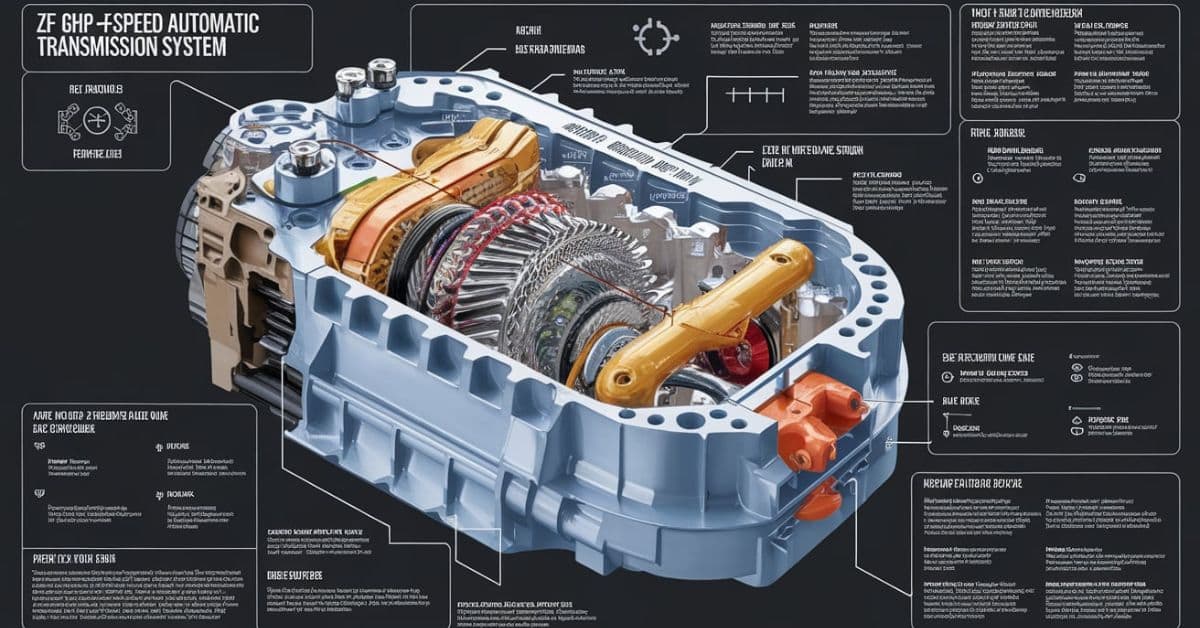ZF 6HP Generation 2 Solenoid Diagram PDF: Everything You Need to Know
The ZF 6HP Generation 2 solenoid diagram PDF provides detailed, crucial insights for those working on or interested in the ZF 6-speed automatic transmission system, one of the most widely used automatic transmissions globally. Known for its reliability and durability, the ZF 6HP transmission has been an essential component in many vehicles, especially in BMW, Audi, Jaguar, and Ford models. The Generation 2 version, with its updated solenoids, brings advancements that improve efficiency and performance, but understanding the solenoid layout and functionality is essential for maintenance, troubleshooting, or modifications.
Whether you’re a car enthusiast, mechanic, or automotive engineer, this article will provide an in-depth look at the ZF 6HP Generation 2 solenoid diagram PDF. We’ll go over the solenoid structure, explain why it’s essential, and analyze how to interpret this diagram to perform necessary repairs or maintenance.
What is the ZF 6HP Transmission?
Before diving into solenoid diagrams, it’s important to understand the ZF 6HP transmission itself. The ZF 6HP series, manufactured by ZF Friedrichshafen, is a 6-speed automatic transmission system used primarily in rear-wheel and four-wheel drive vehicles. Its standout features include:
- Six-Speed System: Provides smooth shifting and improved fuel efficiency compared to older 4-speed transmissions.
- Torque Capacity: Available in various models with torque capacities ranging from 400Nm to 900Nm.
- Adaptability: Widely used in both luxury and high-performance vehicles across many car brands.
The Generation 2 version of the 6HP transmission series brings enhancements to solenoid designs and internal components, offering better durability and shift quality.
Understanding ZF 6HP Generation 2 Solenoid Diagram PDF
The ZF 6HP Generation 2 solenoid diagram PDF is a blueprint or map of the solenoids within the transmission. The solenoids are small electro-hydraulic valves responsible for controlling fluid flow within the transmission, allowing the gears to shift smoothly and efficiently.
Key Features of the Solenoid Diagram PDF
- Visual Layout: The PDF provides a clear visual of the solenoid arrangement within the transmission, which helps users identify each solenoid’s location and function.
- Solenoid Types: Each solenoid has a unique role and design, often labeled as shift solenoids, pressure solenoids, or lock-up solenoids in the diagram.
- O-Ring Sizes: The Generation 2 solenoid diagram also includes information on O-ring sizes, which vary depending on the solenoid type and location.
Why You Need the ZF 6HP Generation 2 Solenoid Diagram PDF
Using the ZF 6HP Generation 2 solenoid diagram PDF is crucial for anyone performing transmission maintenance or repairs. Here’s why:
- Identifying Solenoids: The diagram helps identify which solenoids control specific functions, aiding in targeted troubleshooting.
- Avoiding Misalignments: Knowing the exact positioning prevents accidental misalignment, which can lead to shifting issues or transmission failure.
- Guiding Replacement Procedures: The solenoid diagram is indispensable when replacing solenoids or O-rings, ensuring accurate fitment and preventing fluid leaks.
Detailed Breakdown of ZF 6HP Generation 2 Solenoid Types
The ZF 6HP Generation 2 solenoid system consists of several solenoids, each serving a unique purpose in the transmission. Understanding their roles can help you interpret the solenoid diagram PDF more effectively.
1. Shift Solenoids
Shift solenoids manage gear shifts by controlling the hydraulic pressure within the transmission. They ensure that each gear shift is smooth, precise, and timely. In the diagram, these solenoids are often labeled as:
- Solenoid A: Controls 1st to 2nd gear shift.
- Solenoid B: Manages 2nd to 3rd gear shift.
- Solenoid C: Operates shifts to higher gears (4th, 5th, and 6th gears).
2. Pressure Control Solenoids
Pressure control solenoids regulate the hydraulic pressure for the transmission, allowing for smooth operation across all gears. Key functions of pressure control solenoids include:
- Adaptive Pressure Control: Adjusts pressure based on driving conditions, reducing wear on transmission components.
- Improved Fuel Efficiency: Reduces unnecessary load on the engine by adjusting hydraulic pressure.
In the diagram, pressure control solenoids are often labeled with specific identification numbers that match the service manual.
3. Lock-Up Solenoid
The lock-up solenoid controls the torque converter’s lock-up clutch, which helps improve fuel efficiency and reduce heat generation. By engaging the lock-up clutch, this solenoid minimizes slippage between the engine and transmission, allowing for a more direct power transfer.
4. Line Pressure Solenoid
The line pressure solenoid maintains the hydraulic pressure that powers the transmission’s internal components. It’s essential for preventing clutch slippage and ensuring that the transmission operates under optimal pressure.
ZF 6HP Generation 2 O-Ring Specifications
O-rings play an essential role in maintaining the integrity of the solenoids by preventing fluid leaks. The Generation 2 solenoids use specific O-ring sizes that differ based on the solenoid type and location within the transmission.
- Shift Solenoids: These typically use smaller O-rings to create a tight seal and prevent fluid loss during shifts.
- Pressure Control Solenoids: Often have larger O-rings to handle higher hydraulic pressures.
- Lock-Up Solenoid: Uses O-rings designed to withstand high temperatures since the torque converter generates heat during lock-up.
Common Issues with ZF 6HP Generation 2 Solenoids
While the ZF 6HP Generation 2 transmission is reliable, solenoid-related issues can occur, especially as the transmission ages. Here are some common problems and solutions:
1. Solenoid Failure
Over time, solenoids may wear out or fail, causing rough shifts or delays in gear engagement. If a solenoid fails, replacing it according to the ZF 6HP Generation 2 solenoid diagram PDF is essential to ensure proper function.
2. Fluid Leaks
Improperly fitted or damaged O-rings can lead to fluid leaks, which reduce transmission performance. Referring to the solenoid diagram can help identify the correct O-ring specifications and placement.
3. Electrical Issues
Electrical issues can affect solenoid operation, causing irregular shifting or even transmission errors. Inspecting the solenoid connectors and wiring is recommended if electrical problems are suspected.
Step-by-Step Guide: How to Use the ZF 6HP Generation 2 Solenoid Diagram PDF for Repairs
Using the solenoid diagram PDF effectively involves understanding each solenoid’s location, role, and maintenance requirements.
- Locate the Solenoid: Open the PDF and find the specific solenoid you need to work on.
- Identify the Solenoid Function: Determine if it’s a shift solenoid, pressure control solenoid, or lock-up solenoid.
- Inspect O-Ring Specifications: Check the diagram for the correct O-ring size for your solenoid and make sure you have the right replacement.
- Perform Necessary Repairs: Remove and replace the solenoid or O-ring as needed, referring to the diagram for correct placement.
FAQs About ZF 6HP Generation 2 Solenoid Diagram PDF
Q1: Where can I find the ZF 6HP Generation 2 solenoid diagram PDF?
A: The PDF is often available from automotive repair websites, official ZF service manuals, and transmission specialist resources. Always ensure you have the correct version for your specific transmission model.
Q2: What are the symptoms of a failing ZF 6HP solenoid?
A: Symptoms may include rough or delayed shifting, transmission slipping, or a complete inability to change gears. Diagnostic tools can help identify the specific solenoid that may be failing.
Q3: How often should solenoids be replaced in the ZF 6HP Generation 2 transmission?
A: Solenoids don’t require regular replacement but may need attention if symptoms of failure appear. Replacement intervals depend on driving conditions and transmission fluid quality.
Q4: Can I replace solenoids on my own, or do I need a mechanic?
A: While replacing solenoids is manageable for those with automotive experience, it’s a complex job that requires precision. Using the ZF 6HP Generation 2 solenoid diagram PDF helps, but professional help is advised for less experienced individuals.
Q5: What transmission fluid is recommended for the ZF 6HP Generation 2 transmission?
A: ZF recommends specific transmission fluids for each model, often labeled as “ZF Lifeguard” fluids. Always check the manufacturer’s guidelines for compatibility.
Q6: What makes Generation 2 solenoids different from Generation 1?
A: Generation 2 solenoids come with enhanced durability and updated O-ring sizes, offering better performance and sealing capabilities.
Q7: Why are there multiple solenoids in the ZF 6HP Generation 2 transmission?
A: Each solenoid controls a specific function or gear shift within the transmission, allowing for precise and smooth transitions between gears.
Q8: How can I identify the correct solenoid if the labels in the PDF aren’t clear?
A: Consult your vehicle’s repair manual or ZF service documentation for additional information if the solenoid labeling in the PDF is unclear.






